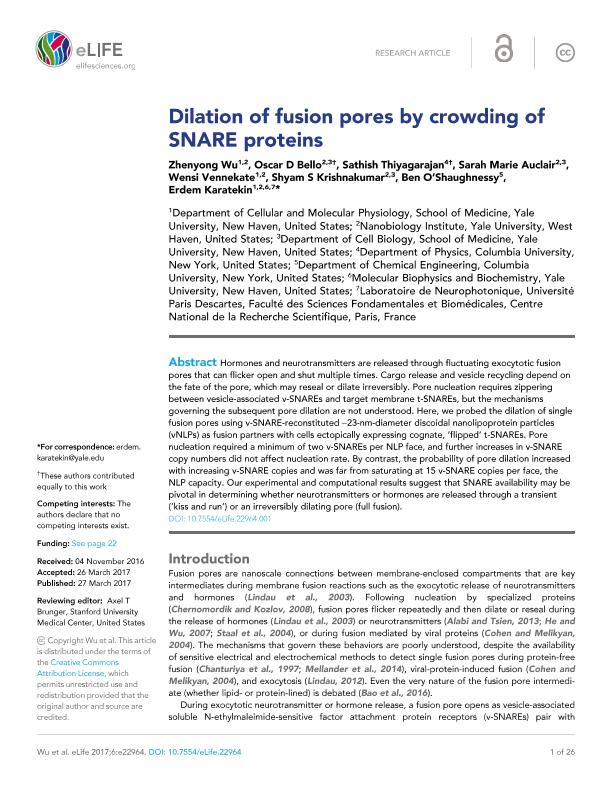Artículo
Dilation of fusion pores by crowding of SNARE proteins
Wu, Zhenyong; Bello, Oscar Daniel ; Thiyagarajan, Sathish; Auclair, Sarah Marie; Vennekate, Wensi; Krishnakumar, Shyam S; O'Shaughnessy, Ben; Karatekin, Erdem
; Thiyagarajan, Sathish; Auclair, Sarah Marie; Vennekate, Wensi; Krishnakumar, Shyam S; O'Shaughnessy, Ben; Karatekin, Erdem
 ; Thiyagarajan, Sathish; Auclair, Sarah Marie; Vennekate, Wensi; Krishnakumar, Shyam S; O'Shaughnessy, Ben; Karatekin, Erdem
; Thiyagarajan, Sathish; Auclair, Sarah Marie; Vennekate, Wensi; Krishnakumar, Shyam S; O'Shaughnessy, Ben; Karatekin, Erdem
Fecha de publicación:
03/2017
Editorial:
eLife Sciences Publications
Revista:
eLife
e-ISSN:
2050-084X
Idioma:
Inglés
Tipo de recurso:
Artículo publicado
Clasificación temática:
Resumen
Hormones and neurotransmitters are released through fluctuating exocytotic fusion pores that can flicker open and shut multiple times. Cargo release and vesicle recycling depend on the fate of the pore, which may reseal or dilate irreversibly. Pore nucleation requires zippering between vesicle-associated v-SNAREs and target membrane t-SNAREs, but the mechanisms governing the subsequent pore dilation are not understood. Here, we probed the dilation of single fusion pores using v-SNARE-reconstituted ~23-nm-diameter discoidal nanolipoprotein particles (vNLPs) as fusion partners with cells ectopically expressing cognate, ’flipped’ t-SNAREs. Pore nucleation required a minimum of two v-SNAREs per NLP face, and further increases in v-SNARE copy numbers did not affect nucleation rate. By contrast, the probability of pore dilation increased with increasing v-SNARE copies and was far from saturating at 15 v-SNARE copies per face, the NLP capacity. Our experimental and computational results suggest that SNARE availability may be pivotal in determining whether neurotransmitters or hormones are released through a transient (’kiss and run’) or an irreversibly dilating pore (full fusion).
Archivos asociados
Licencia
Identificadores
Colecciones
Articulos(IHEM)
Articulos de INST. HISTOLOGIA Y EMBRIOLOGIA DE MEND DR.M.BURGOS
Articulos de INST. HISTOLOGIA Y EMBRIOLOGIA DE MEND DR.M.BURGOS
Citación
Wu, Zhenyong; Bello, Oscar Daniel; Thiyagarajan, Sathish; Auclair, Sarah Marie; Vennekate, Wensi; et al.; Dilation of fusion pores by crowding of SNARE proteins; eLife Sciences Publications; eLife; 6; e22964; 3-2017; 1-26
Compartir
Altmétricas



